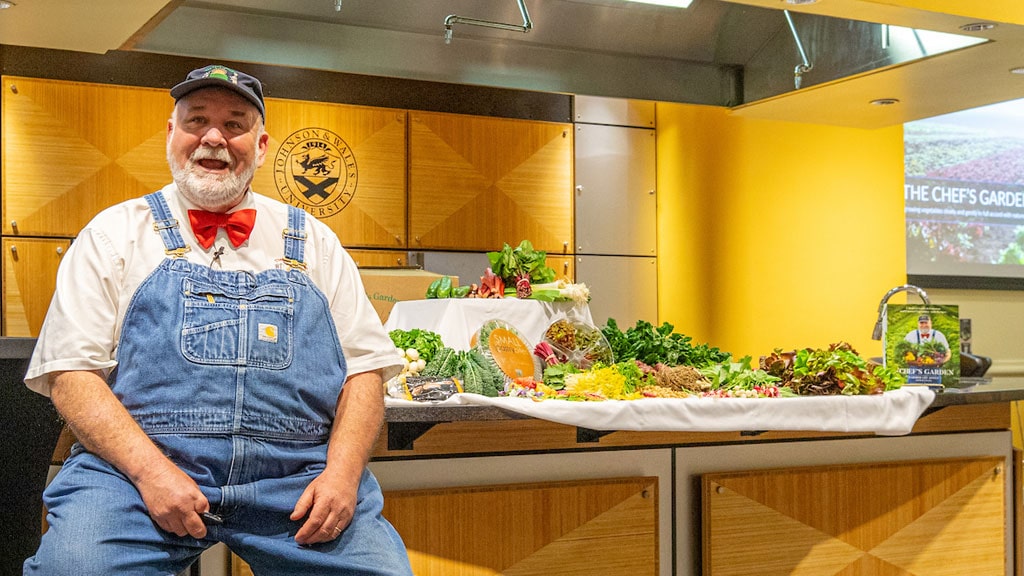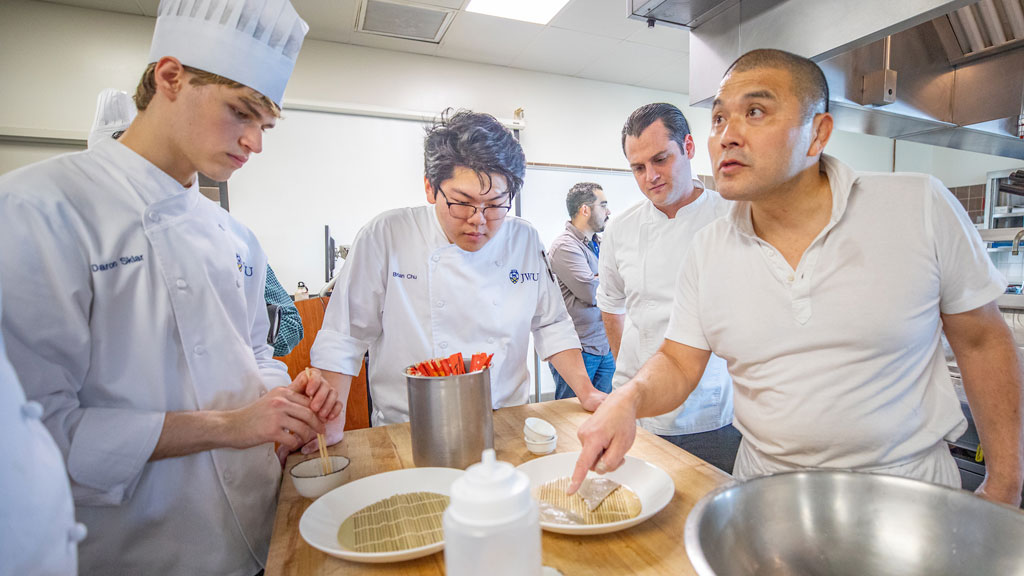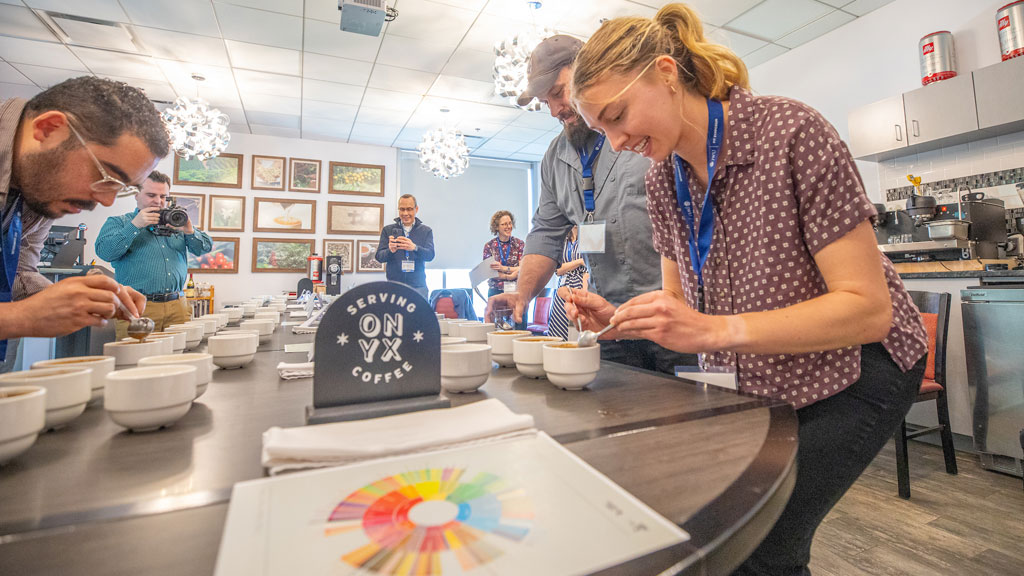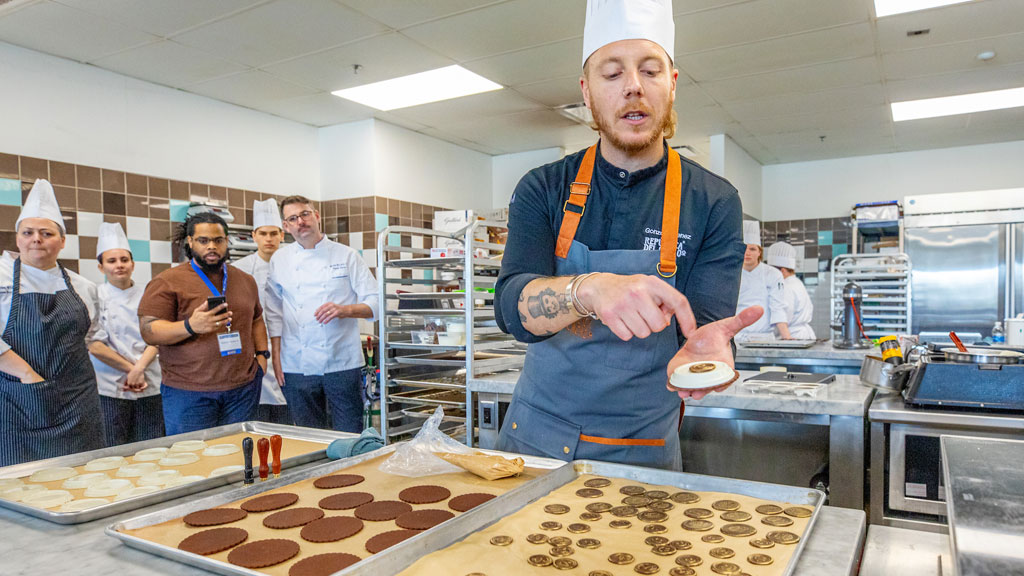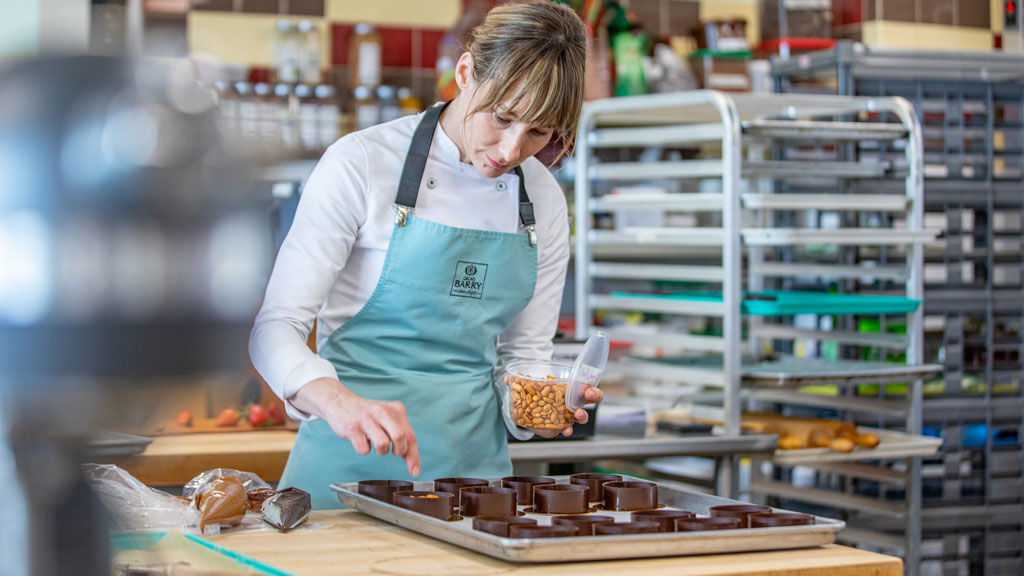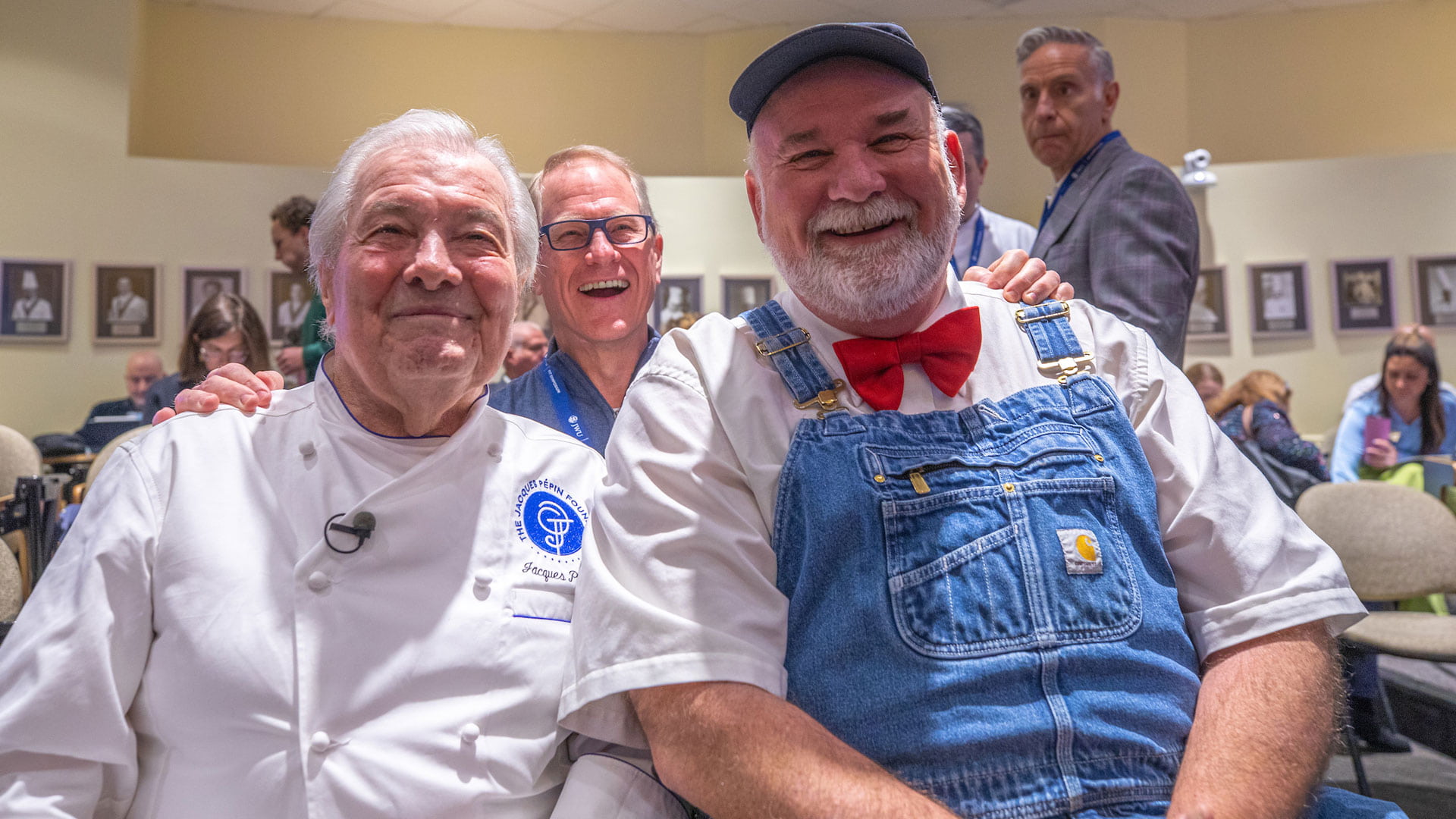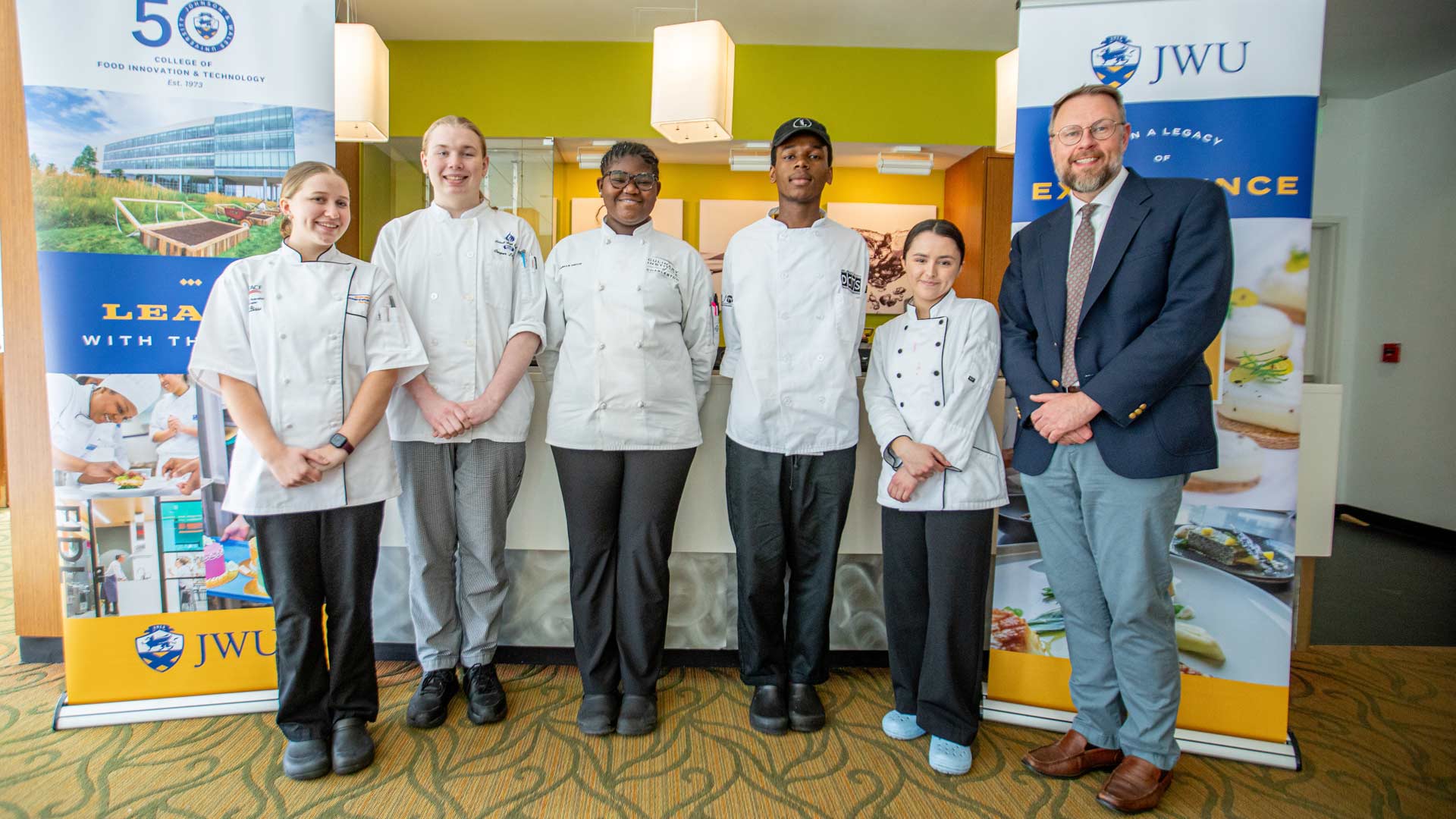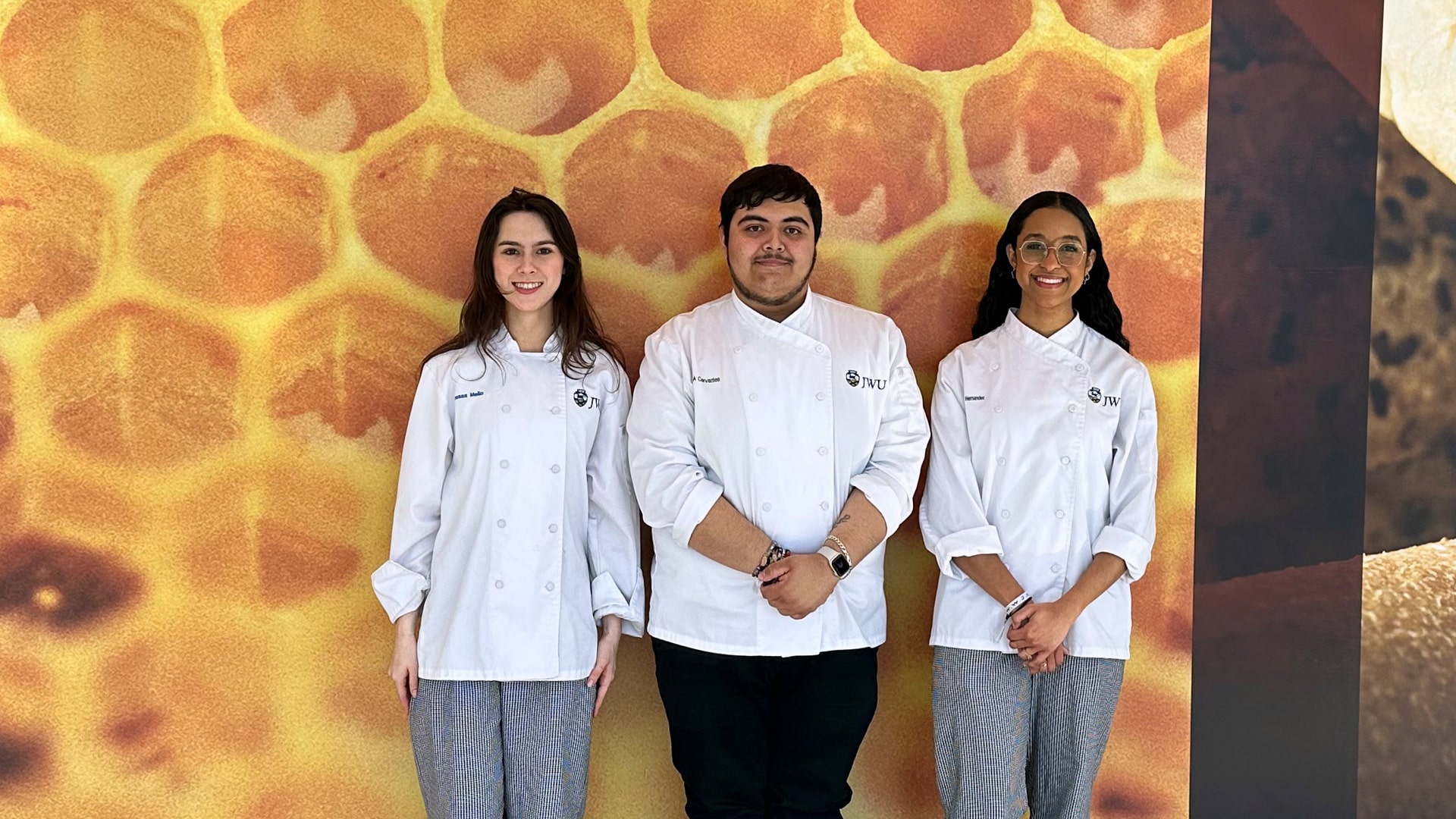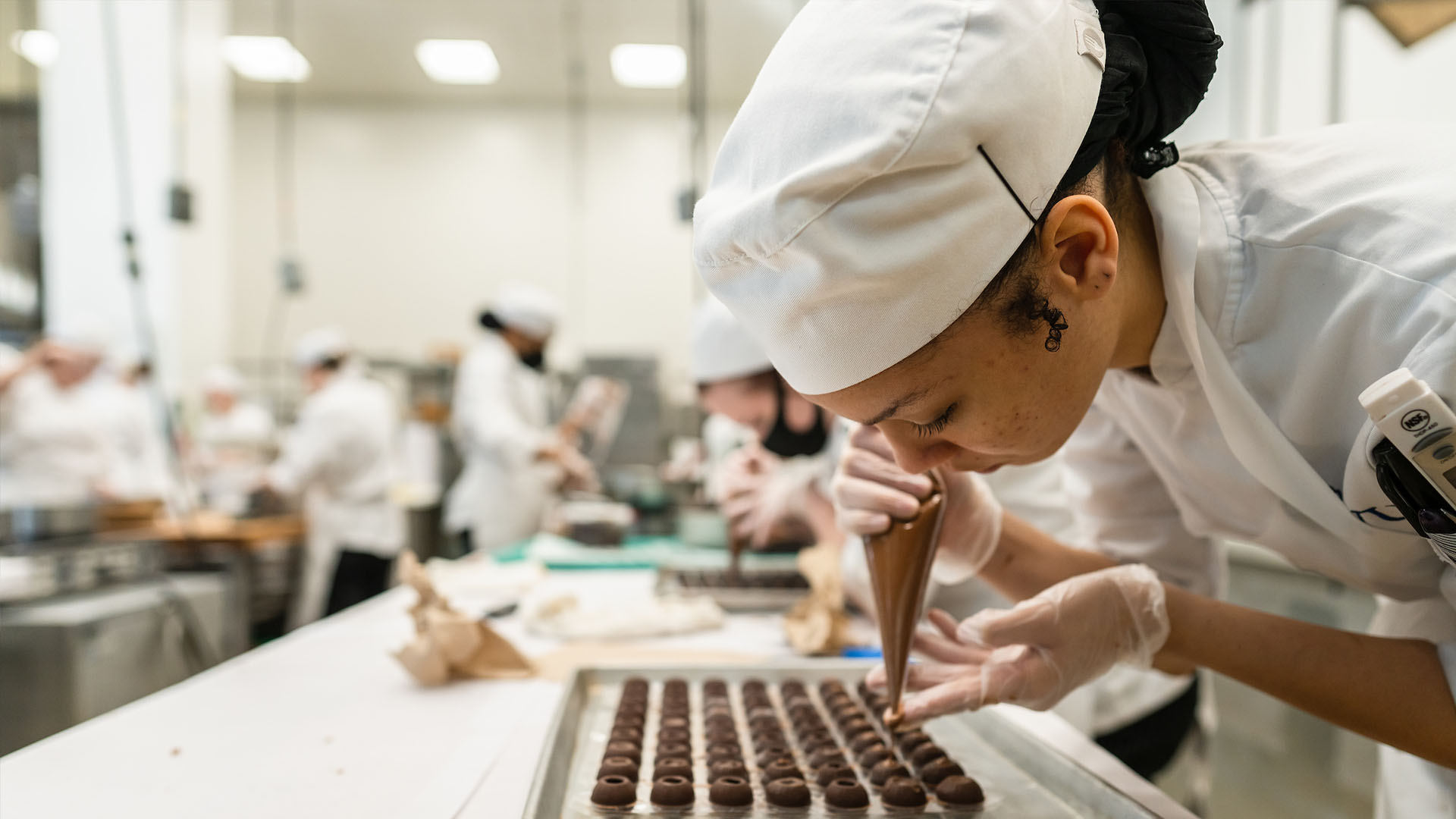FIT Symposium Brings a World of Expertise to Life
With two days of expanded programming, this year’s FIT Symposium focused on bringing a world of culinary techniques to Providence. With a full day of interactive workshops, attendees could try new working methods and learn from experts in soba making, plant-based pastry, coffee cupping, chocolate-making, and more. In addition, Jacques Pépin ’10 Hon. and Farmer Lee Jones shared wisdom from their long careers — Pépin of his 70 years of making people happy with his cooking, whether on PBS or Instagram, and Farmer Lee Jones of his 40 years of sustainable farming.
“Cooking is love. You cannot cook indifferently.” -Jacques Pépin ’10 Hon.
The lively and diverse programming allowed attendees to step out of their comfort zones by exploring subject matter outside their everyday expertise.
The extra time also allowed attendees to discuss ongoing projects and network during communal downtime and breaks. Some already knew one another from previous events at JWU or off-site, while others were meeting for the first time; business cards and ideas were exchanged — possibly for future FIT Symposium workshops or demos.
Here are some of the most unique moments from the two days:
‘Work for the Best People You Can’
Jacques Pépin’s first culinary apprenticeship was in 1949. That’s an astonishing 70 years of “making people happy” with his cooking. His first job in the United States was at Le Pavillion, a temple to French cuisine initially created for the 1939 New York World’s Fair. From there, he jumped to Howard Johnson’s, an American mega-chain with broad appeal, to work as the director of research and development. Speaking with Professor Rollie Wesen, Pépin encouraged every student in the audience to “work for the best people that you can.”
Elaborating, he noted that chefs of Daniel Boulud’s caliber aren’t going to change their cooking methods for you; your job is to learn. “You do that for 5 to 10 years for a number of chefs, and you absorb a great variety of perspectives, knowledge and points of view.”
Wesen agreed, noting that “by the time I wrote my own menu with mashed potatoes, I knew which one of 15 methods was my favorite and exactly how to execute the recipe.” Pause. “Robuchon, 40% butter.”
“Cooking is love,” Pépin concluded. “You cannot cook indifferently.”
View this post on Instagram
Healthy Soil, Healthy Crops, Healthy People
Farmer Lee Jones’ long career in organic vegetable farming began with a tragedy. When he was 19, a freak hail storm wiped out his family farm, which grew conventional produce for large supermarket chains. After the storm, Farmer Lee’s father, Bob Sr., started small by selling at local farmer’s markets. He met a young chef, Iris Bailen Brody, who advised him: “Grow for chefs. Grow for quality. Grow without chemicals.”
The Chef’s Garden was born. Based in Huron, Ohio, the Jones family farms 400 acres, with 50 lying fallow at any time.
“We use technology and AI to find efficiencies for growing,” Farmer Lee explained. “We let the land rest.” (Farmer Lee’s motto is “Healthy soil, healthy crops, healthy people.”)
While the Chef’s Garden does not grow hydroponically (believing that soil grows produce with better flavor and nutrients), its greenhouses are heated with zero fossil fuels. Instead, the farm uses biofuel made from corn cobs, a waste product from a neighboring farm.
Farmer Lee brought a veritable rainbow of produce to showcase the richness and diversity of Chef’s Garden bounty, including crosnes, a tuber that can be eaten raw in salads or cooked, and ice spinach, a nutrient-rich, cold-weather crop.
Such an honor to share the farms philosophy of growing for flavor, for regeneration and for integrity at Johnson & Wales University FIT Symposium yesterday! pic.twitter.com/0LfPY0sfOE
— Farmer Lee Jones® (@farmerleejones) April 19, 2024
Diversifying Our Fisheries to Save Them
Professor Jim Griffin spoke to Tyler Isaac of the Monterey Bay Aquarium Seafood Watch, Briana Warner of Atlantic Sea Farms, and author Barton Seaver about aquaculture’s ability to feed a growing planet. Worldwide, we eat mostly terrestrial proteins – the globe is 70% ocean, yet seafood comprises only 2% of the world’s calorie production.
Warner’s company, Atlantic Sea Farms, is growing its base of kelp harvesters in the Gulf of Maine and New England. “Climate change is wreaking havoc with the Maine lobster fishery,” she explained. “The Gulf of Maine is warming faster than any other fishery in the world. Species are moving, and species are dying. We need to adjust and mitigate now.”
Atlantic Sea Farms is one of the solutions for sustainable coastal farming. This year, the company is on track to harvest a million pounds of kelp and seaweed from more than 4,000 harvesters. “Kelp farming is a winter fishery. It’s a way to diversify during the off-season,” Warner explained.
Warner noted that we must all look beyond salmon and shrimp to the rich diversity of ocean edibles. “Treat unknown or ‘lesser’ fish with respect.” “If we replaced meat just twice a week with seafood, heart attacks would drop by 56%,” added Seaver.
Did You Say Dry-Aged Sushi?
Friday morning began with a primer on ikejime, the Japanese method of killing fresh-caught fish that preserves and maintains the product quality and expands the window of marketability.
Traditional methods of killing fish, like suffocation, invoke the fish’s fight-or-flight response, which then kicks off a biophysical reaction that spikes bacterial activity and damages the flesh through bruising. The more stress the fish undergoes, the more the quality of the flesh is degraded.
Ikejime’s primary goal is to reduce the fish’s stress once caught. The first step is to deliver a spike to the fish’s brain, then quickly bleed it out and rupture its spinal cord. The fish is then put into an ice slurry that keeps bacteria at bay and preserves the meat.
Because of the lack of bacteria, ikejime seafood doesn’t have a “fishy” smell; the flesh is also clearer-looking (no bruising from stress). The flavor of the fish is also improved, with a greater umami (savory) quality. Fish killed using this method have a much longer shelf life — they can even be dry-aged for use as sushi or sashimi.
The 2nd part of the #FITSymposium ikejime presentation is highlighting a recipe competition funded by a USDA Higher Education Challenge Grant. We ate samples of two @JohnsonAndWales student recipes: A rock fish ceviche and a butter-poached rock fish. pic.twitter.com/AdT0BQejHL
— JWU Culinary (@JWUCulinaryNow) April 19, 2024
Introducing ikejime to Rhode Island has been a collaborative effort. URI’s Hirotsugu Uchida received a Partnership for Research Excellence in Sustainable Seafood grant to train a hand-picked group of local stakeholders — fishermen, fishery experts and others — in the method and the science behind it.
In addition, URI and JWU were awarded a USDA Higher Education Challenge grant to introduce ikejime to future chefs via a recipe contest.
TJ Vadney’s winning dish featured black bass, smoked Jerusalem artichoke purée, pickled shiitakes and brown-butter dashi. Second place was a collaborative dish from Sullivan Mousseau and Elijah Velasquez consisting of a coconut ceviche with a tropical leche de tigre. Their dishes were shared with FIT Symposium attendees.
A World of Techniques, from Soba to Chocolate
Friday’s full slate of interactive workshops brought a world of expertise and technique to life, from the fine art of Japanese soba-making to complex methods of tempering chocolate.
The Argentinian chocolatier Gonzo Jiménez admits that his favorite flavors come from childhood — “milk chocolate and caramel, peanuts and Snickers bars” — but he is known for his outrageously beautiful confection designs. A frequent competitor on Netflix’s “Bake Squad,” he is also a chef-partner of the Ecuador-based bean-to-bar chocolate company República del Cacao.
Finished chocolates from Gonzo Jimenez’ #FITSymposium chocolate workshop. Jimenez covered a lot of ground, from fixing over-crystallized chocolate and dipping techniques to getting a perfect ganache every time. pic.twitter.com/RCDRZVzbjA
— JWU Culinary (@JWUCulinaryNow) April 19, 2024
During his workshop, he noted that he tries to avoid trends. His favorite ingredient? “Dulce de leche — Argentinian superglue!” He also hates the idea of guilty pleasures. “Guilty pleasures? No! I’m a grown man.”
Is soba easy to make? Akiya Ishibashi makes it look deceptively simple, and his deftness with sifting, rolling and cutting the buckwheat dough into uniform, pliant strands was a joy to watch. He has owned his 6-seat Kyoto soba restaurant, Juu-Go, for 7 years; he is close to opening another restaurant. He also grows all of the buckwheat used in his soba himself. (“I’m not a chef; I can’t cook. I’m a farmer,” he told the crowd during his earlier demo.) Tasting his cloud-like soba was an otherworldly experience.
Making plant-based pastries and confections can be tricky, thanks to variables in commercial products like vegan milk, which vary wildly in viscosity. Do you make a dry or wet caramel? Do you leave the skin on nuts or remove them?
Chef Lauren Haas typically makes half and half and slow-roasts them at 180° to bring out their best flavor. (The richness helps offset the lack of butterfat in plant-based confections.)
Lauren V. Haas is demonstrating how to temper a pistachio chocolate for a plant-based strawberry pistachio tart. #FITSymposium pic.twitter.com/QUc2So5gGH
— JWU Culinary (@JWUCulinaryNow) April 19, 2024
During her two-hour workshop, Chef Haas had the FIT Symposium attendees — including several current students and alums — run through an impressive number of techniques. The end result was a table full of finished tartlets and confections for everyone to try at the end of the day. A sweet end to a great event!
